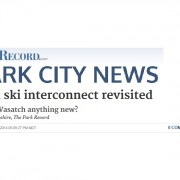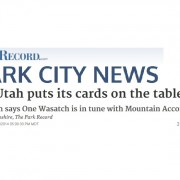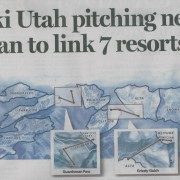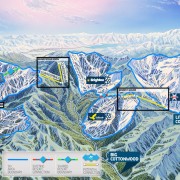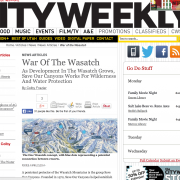By Maggie Hughey AbuHaidar
ONE Wasatch would connect the 7 world-class ski resorts in Park City, Little and Big Cottonwood Canyons, on private land with private money, providing access to 18,000 skiable acres, 750 named runs, and 100 lifts—with a single lift ticket. An interesting new concept? “An interesting old concept,” gently corrected Park City Mayor Jack Thomas, who remembers the interconnect idea being kicked around as long as forty years ago. One might wonder why, if it’s such a good idea, it hasn’t been done yet. Nathan Rafferty, President and CEO of Ski Utah, assures me that the idea has “stayed around because it’s a good one, but so complicated that no one’s pushed it.” Until now.

While there seems to be no single reason why Ski Utah finally decided to take the first step in creating a Central Wasatch interconnect—if announcing the concept can be considered a step—there are several reasons why it may be the right time to do so. For one, all 7 resorts have agreed that it’s the right time. When Ski Utah unveiled the concept in mid-March, the general managers of Snowbird, Alta, Solitude, Brighton, Canyons, Park City Mountain Resort (PCMR), and Deer Valley were all there. Resorts that are in direct competition with each other—including two that are locked in a very public lawsuit—have joined forces because the concept, as they see it, will be good for the Utah ski industry as a whole.
Utah is, after all, in the ski and snowboard business. The ski industry contributed $1.29 billion to the state’s economy during the 2012-2013 season, $1.076 billion of that coming from out-of-state and international visitors. This represents about a 10% increase over the 2010-2011 season. But the business of attracting skiers to Utah remains a cutthroat one, because the pool of people who ski is limited and our main competitors are close-by. At the end of the day, “it’s a business decision,” said Onno Wieringa, General Manager of Alta, when asked about ONE Wasatch, adding that, “As a ski area, I think we need to fight for our industry. One part of that is to make more people who ski come to Utah.”

Ski Utah thinks that the ONE Wasatch concept might do just that. As Mr. Rafferty explains, “The ski industry is not unlike other businesses, it must constantly innovate and improve its product.” ONE Wasatch could do both. With the addition of 4 inter-resort connections using 6 ski lifts, it would create the largest ski complex in North America, easily eclipsing Big Sky and Vail, at 5,532 and 5,289 acres, respectively. Even Whistler Blackcomb in British Columbia, the current largest ski area in North America, is relatively small at 8,171 acres. Not only would ONE Wasatch become the largest in North America, but it would stay that way. It is Utah’s unique geography, with 7 resorts located in a twenty-square-mile radius, that makes the interconnect even possible. As Deer Valley General Manager Bob Wheaton observed, “All of the resorts recognize that, from a marketing standpoint, this is an opportunity that no one else in North America can duplicate.”
This opportunity positions Utah well in a market where “the trend has been for larger resorts,” observed Dave DeSeelhorst, General Manager of Solitude. As lifts move more people more quickly, grooming techniques reach more advanced terrain, skis go faster, and clothing keeps people warmer, skiers “can and want to cover more terrain in less days—more terrain on their vacations.” Individual resorts face pressure to expand to accommodate their skiers’ desires for more. The interconnect would allow the Central Wasatch resorts to expand their offerings without creating new terrain. In effect, ONE Wasatch would offer Utah skiers a larger, virtual ski hill, by eliminating resort boundaries. The days of spending your whole family ski trip within the borders of one ski resort would be over. Unlike creating one massive resort, however, the character of each individual resort would be preserved. People would still be able to frequent their favorite mountains, towns, inns, and watering holes, albeit with a little more daily flexibility over the snow.
Utah ski resorts believe in their product and believe that, once they get new skiers to try Utah skiing, they will inevitably come back. ONE Wasatch is one more reason for skiers to try us out. The concept is thus intended to increase visibility and marketability, which should, in turn, translate into increased skier days and revenue. Utah currently enjoys about 4 million skier visits per year. Mr. Rafferty believes ONE Wasatch will attract national and international attention sufficient to rival the post-2002 Olympics bump, or about one million additional annual skier visits over five years. Others, including Mr. Wieringa, Mr. Wheaton, and Mr. DeSeelhorst, are more conservative, hoping for a 10-15% increase over time. Even this more moderate bump would not be insignificant. Based on recent estimates of how much skiers spend on an average day, an increase of just 10% could yield about $130,000,000 in additional annual revenue.
These skier days and revenue would be spread among 7 resorts and the many towns that provide pillows and bar stools. And, for now, there seems to be plenty of room for them. Bob Bonar, General Manager for Snowbird, feels that the Central Wasatch has the ski runs, hotels and restaurants to easily “go to five or six million skier visits per year.” Mr. DeSeelhorst and Mr. Wieringa agree that the resorts are all operating under capacity. According to Bill Malone, the President and CEO of the Park City Chamber of Commerce and Visitors Bureau, there are also plenty of empty beds in Park City, where lodging averages only 50% occupancy. Of course, it’s closer to 80% during peak times, but that still leaves almost 5,000 empty pillows during Christmas.
This increase is obviously supported by the 7 participating resorts, but also by those resorts that are arguably marginalized by the concept. John Loomis, Snowbasin Resort’s General Manager, looks at ONE Wasatch as “just one more arrow in the quiver of skiing in Utah.” If the concept makes someone come to Utah who would ordinarily go to California or Colorado, Mr. Loomis figures, they’ll come back and the next time they might branch out. Surprisingly, California seems to look at it much the same way for a similar reason. Brook Taylor, from the California Governor’s Office of Business and Economic Development, wished Ski Utah “the best of luck, especially if it encourages more international tourism.” In other words, “a rising tide raises all boats,” to borrow a well-worn phrase from Mr. Loomis.

Not only does ONE Wasatch enjoy broad industry support and seem to make business sense, but technology has largely solved logistical issues regarding revenue-sharing and ticketing that, at one time, might have seemed prohibitive. By making it possible to track a skier’s lift usage, technology allows the resorts to determine what percentage of a skier’s time is spent where and to share revenue accordingly. According to Mr. DeSeelhorst, Brighton and Solitude implemented this method with their Big Cottonwood pass this year with much success. So, the issue is not whether the 7 resorts can share revenue, but rather, when they will adopt the system allowing them to do so. Although Ski Utah has not determined how the ONE Wasatch ticket will be priced, technology can also help with cost-containment, by giving Ski Utah pricing flexibility. That is, the ticket could be priced for one resort, all 7, or anywhere in-between. “The resorts could even sell a pass for one lift,” Mr. Rafferty explained. “It’s that scalable.” Regardless, Mr. Rafferty and Mr. DeSeelhorst agreed that the resorts wouldn’t go to all this effort and then price the experience so high that it won’t get used.
Importantly, ONE Wasatch can also be accomplished on private land with private money. That is, the necessary ski lifts would be built by the resorts on resort-owned property. Although this in no way eliminates the need for permits and public input, it considerably simplifies the process. In particular, the three Park City resorts could be connected with as few as three permit applications. As PCMR General Manager Jenni Smith explained, these connections “will be fairly straightforward. All are on private land within the county or City boundaries and these connections have been contemplated for some time.” Even Mayor Thomas, who refused to weigh in on the interconnect concept as a whole, admitted that “there is support for a Park City interconnect. It can be done responsibly, easily and without a dramatic impact.”
Although the PCMR-Brighton and Solitude-Alta connections are also on private land, they will require additional review due to their locations. While the PCMR-Brighton connection has raised little concern, the Solitude-Alta connection through Grizzly Gulch has been met with loud protest. Volume alone will not win the argument, but Ski Utah will face valid questions relating to watershed protection, backcountry access, and transportation. The resorts can cite water studies to prove that water impacts have been and will be mitigated. They can argue that backcountry skiers should be less obstructionist and more willing to help develop long-term, sustainable, backcountry access in Little Cottonwood Canyon. They can point to on-going transportation planning by the Mountain Accord to demonstrate that the issue is being studied. However, whether they win these arguments administratively may be less important than whether they win them in the court of public opinion.

How ONE Wasatch as a whole may impact Park City is also a valid concern. Surrounded as they are by public land, Little and Big Cottonwood Canyons face development restrictions not present in Park City. As the primary bed-base for the concept, Park City may need to grow to accommodate ONE Wasatch. Mr. Rafferty viewed this dilemma as a “great problem to have.” Mr. Malone and Ms. Smith both felt that Park City could absorb the additional visitation, as it would occur over time. Although the town may technically have sufficient places to sleep and eat, and even more room to grow in that regard, the roads are busy and the parking lots are already full. Adding even more cars to this congestion concerns many locals. Mayor Thomas, Mr. Malone, and Ms. Smith all stressed that careful transportation planning would be necessary, perhaps in conjunction with the Mountain Accord.

As an active participant in the Mountain Accord, Ski Utah is already engaged in long-term economic, environmental, recreation, and transportation planning for the central Wasatch Mountains. That the Mountain Accord is already in place may very well be the last reason why ONE Wasatch’s timing is right. ONE Wasatch does not need a stamp of approval from the Mountain Accord to proceed, but it should take advantage of the opportunity the process offers—to bring all interested players to the table—to work through the concept. This sentiment was recently shared by Brad Petersen, Director of the Utah Office of Outdoor Recreation, who expressed concerns about transportion, backcountry access and safety, and the future threat of continued resort expansion. He encouraged Ski Utah to facilitate the evaluation of ONE Wasatch through the Mountain Accord. Done in that way, Mr. Petersen felt “cautiously optimistic that . . . ONE Wasatch can mitigate the concerns and build consensus for the project.”
This cautious optimism is shared by many who are excited by the possibilities that ONE Wasatch presents but mindful of its potential difficulties. As Mr. Bonar said, “ONE Wasatch is a great way to do something really cool if it can be done in an environmentally-friendly way.” Through the Mountain Accord, open discussion, education, and perhaps a few, good, long hikes through the proposed interconnect areas, this “if” is attainable. Compromise is possible and to be encouraged, by both sides, because ONE Wasatch is an old idea whose time has finally come.
Wasatch Talk
By Louis Arevalo
“Ski resort GM’s line up to back ‘One Wasatch” was the headline of the Salt Lake Tribune Wednesday March19, 2014. The article referred to it as an historical event. Ski Utah, the marketing group representing each of the state’s resorts, announced the ski areas of the central Wasatch had agreed to work on making connections that would enable a person to visit all seven resorts with one ticket. According to the One Wasatch webpage these connections would be developed on private land and that this concept could be a reality within a few seasons. Further along the article stated that this connected Wasatch would be done with a collaborative effort presented through the Mountain Accord process, of which Ski Utah is a member. They conclude that when completed Utah could then boast that its skiing had better access and more options than the competition.
The map displayed on the One Wasatch website highlighted areas of the possible connections. The Monitors on the Park City Ridgeline between The Canyons and Park City Mountain Resort, Park City to Brighton over Guardsman’s Pass to Hidden Canyon, and Twin Lakes Pass and Grizzly Gulch between Solitude and Alta. These three areas are known in the local community as being areas of backcountry use. With this announcement Utah’s ski and snowboard industry had painted a bright picture of what their future might be, but what did others think?
“Who wants this expansion?” Salt Lake resident, physician, and photographer, Howie Garber asked. For the past 30 years he’s been fighting for local conservation and has authored the book, “Utah’s Wasatch Range: Four Season Refuge”, that makes a compelling case for preserving the very mountains the One Wasatch Concept would impact. I’d stopped by his house to get a signed copy. Sighting the Wasatch Tomorrow study, conducted between 2009-2010, Howie continued, “94% of the 16,000 citizens surveyed supported limiting resort expansions… When do local populations get an opportunity to determine how much takes place in their backyard? They’re building something for the sake of the tourists!” Howie was obviously concerned. He’s witnessed backcountry terrain in the mountains next to the Salt Lake Valley slowly gobbled up by ski area expansions; The Supreme lift at Alta, Honeycomb Return at Solitude, and Snake Creek and Great Western lifts at Brighton. His concern also carries over to the watershed, environment, development, lift prices, increased traffic and global warming. “40 years from now winters in Utah are going to look entirely different,” referring to the predictions that the winter snowlines in the Wasatch will retreat to higher elevations.

Echoing Howie’s concern is Carl Fisher, executive director of Save Our Canyons (SOC), a community driven conservation group whose focus is on preserving the Wasatch Mountains, who told me that SOC was adamantly opposed to the One Wasatch Concept. He feels any further expansion would be a compromise on top of the compromises SOC has already made with the resorts. Save Our Canyons was actually created by locals who were concerned with overdevelopment of the Wasatch in response to the building of Snowbird Ski Resort in 1972.
A native of the Wasatch Range, Carl has been at SOC since 2001. He carries a spark in his eyes that is obviously fed by passion for his work. “We’ve received over a thousand comments since One Wasatch was announced,” Carl energetically continued. “Even out-of-state visitors say it will ruin why they come; which is easily accessed resorts and easily accessed backcountry.” Carl feels the local ski area’s appetite for expansion will never be sated and that this latest campaign is ill conceived. “One Wasatch is simply a talking point to help Utah compete with Colorado, California and international destinations.” He followed this up with some statistics. Skier days in Utah are on the rise mainly through backcountry use. SnowSport Industries of America puts backcountry users at over 5 million, signaling to Carl that Ski Utah is stepping on the toes of the out-of-bounds skiers with this move. That brought me back to Howie’s initial question, “Who really wants this?”

If Save Our Canyons could put a price tag on dispersed recreation then maybe more people would get on board with preserving the open spaces. To get more information on users of the Wasatch Mountains, SOC in partnership with Salt Lake City and the US Forest Service is rolling out dispersed recreation surveys this spring. They are hoping to use the data to gain a better understanding of the economic value of this natural resource. When asked about the links taking place on private land Carl responded that until we could see actual lift alignments there was not much to say. He did say that even if the towers were on private land, public lands would come into play, as well as the watershed, and the environment. However, Carl does hold some optimism that the concept will be run through the Mountain Accord of which he is an executive board member. “You should talk to Laynee Jones.”
“When are you going to write an article about the Mountain Accord?” Program director Laynee Jones had caught me off guard. “We have the decision makers at the table (cities, government entities, businesses, private sector and the public). It’s a real powerhouse and they’re here to find solutions and willing to compromise. This has never been seen before.”
She had a point. A civil engineer with experience in transportation and environmental consulting, Laynee had moved to Utah to live in the mountains. Being an active member of the outdoor community she’s focused her work on integrating manmade development with the natural world. Through the Mountain Accord Laynee sees an opportunity to do something remarkable that will preserve the Wasatch for generations to come. I didn’t have an answer for her at the time, but maybe “now” is appropriate.

What is the Mountain Accord? In brief it’s a progressive approach to develop a blueprint for future planning of the Central Wasatch Mountains of Utah. Using findings from previous studies the Mountain Accord is currently focused on developing guidelines for the area east from the Salt Lake International Airport to Summit and Wasatch Counties and from Interstate 80 south to the Little Cottonwood Canyon Divide. One key element that should not be overlooked is that this whole process is open to the public. Anyone may submit comments in writing or online, review the group’s documents and attend stakeholder meetings.
Laynee explained that currently the four systems groups of transportation, environmental, economic and recreation are independently gathering best-course-of-action ideas for their individual sets for the next 150 years in the study area. This August all groups will be presenting their idealized scenarios. As Laynee described it they will figuratively be laying plans one on top of each other to discover how closely or how far apart each plan lines up. She predicts there will be huge areas of agreement and small areas of disagreement.
When I asked Laynee about One Wasatch she responded that the concept would have to be presented to Mountain Accord through one of the groups. She then clarified that there is agreement from all parties and entities involved with the Mountain Accord on preserving the Wasatch with an emphasis on the transportation issues. In fact everyone I spoke with agreed that when it came to transportation there was room for improvement. “This is an area where we can’t afford to do nothing.”
My next conversation was with Black Diamond Equipment’s CEO and Mountain Accord executive board member, Peter Metcalf. He had multiple perspectives on the One Wasatch Concept. Personally he is against ski area expansion and, like Carl, wants a better understanding of the value of the surrounding open spaces. In the past 25 years, since bringing Black Diamond Equipment to Salt Lake, the expansion of ski resorts within the Wasatch Mountains has been a constant fight. The availability of inbounds and out-of-bounds skiing was one of the initial reasons the company chose the Wasatch. His second perspective comes from his professional experience. He considers the One Wasatch Concept a marketing move to attract more skiers to the state and understands Ski Utah’s desire to one-up the competition, but he doesn’t buy it. “Who’s really going to ski all resorts in one day and is it even possible without sitting on lifts all day long AND doing mediocre traverses?” Peter continued by reflecting items I’d heard from Carl, Howie and Laynee. Winter backcountry use throughout the Wasatch is growing as well as summer use. These segments of users (hikers, bikers, campers, climbers) have to be considered in the overall plan.

Like Carl, Peter was also hopeful there could be a positive outcome. He counseled to move forward slowly and get the community involved. And if the resorts really want to pursue these connections he had some ideas. In the interest of finally putting an end to ski resort expansion he has come up with a scenario dubbed the “Grand Bargain.”
“To me that grand bargain would be defined as approval of the interconnect as part of a much larger Wasatch agreement that would include the following: a route that was the least impactful to the existing Wasatch backcountry ski experience, minimal & defined prepared piste on the sides of the lifts, guaranteed access to backcountry skiers of the linked zones, full support of the expanded Matheson Wasatch Wilderness Bill, a giving up of all future development rights (assign to Utah or Summit County open lands) via conservation easements on all private lands surrounding the new lifts, binding agreements between the ski areas and the forest service to never expand the ski areas beyond their current boundaries, and an abandonment by Snowbird of their desire to build a tram from the top of Hidden Peak to the top of American Fork Twin Peaks.”
Peter had given me a lot to consider. I needed to follow up with Carl.
Carl wasn’t super enthused about Peter’s “grand bargain” idea and left me with this statement. “What we have today (in the Wasatch) can’t be found anywhere else in the world. It’s what puts Utah on the map. Losing it would be to the detriment not only of the ski areas but the greater Utah economy.”
Eventually I was back where I began, sitting in Howie’s living room asking questions.
Over the next 30-40 years the population of Utah is predicted to double and with it so will the pressure on the Wasatch Mountains. Having the ski industry focused on growing their numbers while the community faces the issues of clean air, growing populations, transportation, watershed, environment and development is all part of the picture. Who wants One Wasatch? I’m sure tons of people who are connected to the ski tourism industry and love skiing at Utah’s resorts. Who doesn’t want this? Maybe people who find refuge in this small gem of a range. And I’m certain there are people who want both. Howie broke the heaviness in the air.
“The bottom line, Louie, is that it’s about the preservation of powder skiing, which I truly believe is a dwindling natural resource!” We both laughed, but he was serious. For him it’s powder, for someone else it could be wildflowers and others, the value they find in open space. For Ski Utah it’s sharing our world-class terrain. If we can agree that everyone is passionate about preserving the Wasatch then the only question we need to ask is how can we do that best?
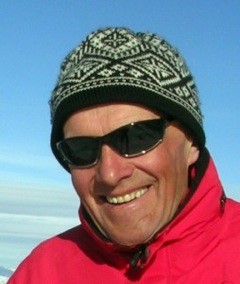 Almost 30 years ago, when I decided to make Utah my home, I was struck by certain similarities between the Wasatch mountains and “Portes du Soleil,” a major ski interconnect weaved around Morzine, the French ski town where I grew up in the Alps. Even though it boasts more than 200 ski lifts, like Courchevel and the Three Valleys, this huge area was never planned to be interconnected.
Almost 30 years ago, when I decided to make Utah my home, I was struck by certain similarities between the Wasatch mountains and “Portes du Soleil,” a major ski interconnect weaved around Morzine, the French ski town where I grew up in the Alps. Even though it boasts more than 200 ski lifts, like Courchevel and the Three Valleys, this huge area was never planned to be interconnected.



